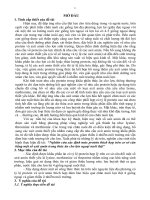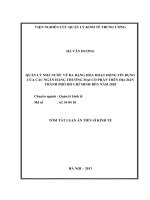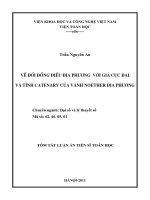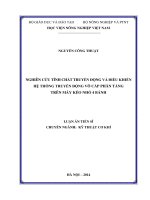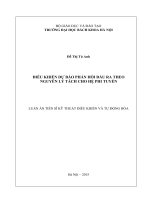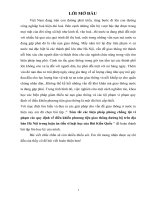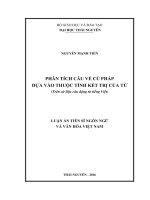4 luan an tien si ve protein tren bao ngu 2000
Bạn đang xem bản rút gọn của tài liệu. Xem và tải ngay bản đầy đủ của tài liệu tại đây (807 KB, 152 trang )
THE PROTEIN REQUIREMENTS OF THE SOUTH AFRICAN
ABALONE, HALIOTIS MIDAE
Submitted in fulfilment of the
Requirements for the Degree of
DOCTOR OF PHILOSOPHY
Rhodes University
by
Thomas A. Shipton
December 1999
II
CONTENTS
ACKNOWLEDGEMENTS………………………….…………………………… IV
ABSTRACT…………………………………………………….………………… V
CHAPTER 1. INTRODUCTION………………………………………….……… 1
CHAPTER 2. AN ASSESSMENT OF THE USE OF CHROMIC OXIDE
IN DIGESTIBILITY TRIALS FOR HALIOTIS
MIDAE…………………………………………………………….. 9
CHAPTER 3. EVALUATION OF AN IN VITRO DIGESTIBILITY
TECHNIQUE FOR THE PREDICTION OF PROTEIN
DIGESTIBILITY IN FORMULATED FEEDS FOR HALIOTIS
MIDAE…………………………………………………...………… 32
CHAPTER 4. EFFECTS OF ANIMAL SIZE ON THE ABILITY OF HALIOTIS
MIDAE TO UTILIZE SELECTED DIETARY PROTEIN
SOURCES…………………………………………………………. 49
CHAPTER 5. REPLACEMENT OF FISHMEAL WITH SELECTED PLANT
PROTEIN SOURCES IN FORMULATED FEEDS FOR
JUVENILE HALIOTIS MIDAE……………………………………. 74
III
CHAPTER 6. INVESTIGATIONS INTO THE QUANTITATIVE AMINO
ACID REQUIREMENTS OF HALIOTIS MIDAE……………….…
103
CHAPTER 7. CONCLUDING DISCUSSION……………………………………… 120
REFERENCES………………………………………………………………………. 125
IV
ACKNOWLEDGMENTS
Many people have played a role in this work – peers, sponsors, friends. Without my peers I
wouldn’t have learnt how to approach the problems, without the sponsors I couldn’t have
afforded to address the problems, and without my friends, well, I’d have packed up long ago and
gone home……. so while I am grateful to them all, there are a number that I must mention
individually.
Firstly, my supervisor Pete Britz. As a student, supervisors come one-a-penny, and while in my
time I seem to have crossed a few of their paths, Pete has been the exception. Whether it has been
persuading a non-surfing shark scared, pale pasty Englishman to jump off Port Alfreds West pier
into barreling six foot surf; letting me wander off with my ideas about nutrition – and then,
sometimes having to pick up the pieces; suggesting I take this or that into account; encouraging
me through the darkest hours; the unenviable re-reading of scripts; what can I say Pete – thanks.
Much of the experimental work was carried out at the Port Alfred Marine Laboratory –
endearingly known by those who work there as Legoland. The work would not have been
possible without both a sense of humour and the help from Bucs and Jerri. What with Bucs and
his experimental diving techniques, Jerri losing his beard, me, my refrigeration plant – I had a lot
of fun, and can’t thank you enough for being there for my abalone.
The departmental statistical gurus Horst Kaiser and Tony Booth are thanked for their help
deciphering the numbers. Their courage in the face of continual barrages of daft questions will
not go unforgotten. Thanks to dear Madam Anu, may you rest in peace now, finally write up, and
stop sending me microbiological papers through internal mail that complicate an already
complicated life……. and of course Abby for the arguments.
I am indebted to my sponsors : Sea Plant Products ltd., Hermanus Abalone ltd., The National
Research Foundation, Rhodes University Joint Research Committee and THRIP. In particular, I’d
like to thank Craig Clayden (Sea Plant Products Ltd.) for his infectious enthusiasm for the
project, preparation of diets and the constant supply of experimental animals. Marrianne Hundley
for the University of Natal for her input with the amino acid work. Mr Morley (Pharmacy Dept.)
for advice, and allowing me access to his facilities.
Protein sources for the experimental diets were kindly donated by : EPOL SA, Esbjerg
Fiskeindustri, Fiskernes Fiskeindustri, National Sorghum Breweries, Illova Sugars Ltd., Abakor
Ltd., Sopropêche.
To Nico, KJ and Mr Aart – through the kaleidoscope of their sanity, they became the guardians of
mine. Indeed rare people that walk the earth. Thank you for your love and support. Candice – for
whom words are a little difficult now, thank you for everything. Rob – so the joke continues !
And finally to my parents, who have always held an unflinching belief in my education. Back in
the autumn of 1974 they packed a pink blazered little boy off to the Hall School, Hampstead. Cap
shorts and a cheesy grin – little did they know that his formal education would come to a close 25
years later ! For them mere gratitude is not enough.
V
ABSTRACT
The potential to reduce feed formulation costs by the replacement of existing protein
sources in artificial feeds for Haliotis midae was assessed. A comparison between the
efficacy of the direct method and chromic oxide marker techniques in determining
apparent protein digestibility coefficients, revealed that while the former was not a
suitable methodology for use with this species, the latter produced replicable and reliable
results. It was established that the chromic oxide marker is inert, is not absorbed by the
abalone, does not interfere with the digestive processes and moves through the intestine
at the same rate to the protein. However, as this method was time consuming and
expensive to implement, a multienzyme pH-stat in vitro protein digestibility technique
using a three enzyme system was employed to rapidly assess the protein quality of 34
protein sources. The efficacy of the technique was established by correlating the in vitro
digestibility estimates with in vivo digestibility coefficients obtained using the chromic
oxide marker technique. The highest degree of in vivo predictability was attained when
protein sources were separated according to origin, and significant correlations between
either animal (r2=0.89, P<0.004) or plant (r2=0.79, P<0.04) protein sources were found.
The effect of animal size on the qualitative protein requirements of two size classes of
H.midae was assessed by feeding 12 isonitrogenous and isoenergetic single protein diets
to juvenile and young adult animals (10-20 and 40-50mm shell length). The criteria for
protein source selection were their bioavailability as determined using the pH-stat in vitro
digestibility technique, and their cost and availability within South Africa. The protein
sources identified for the trial comprised four fishmeals, casein, spirulina, abalone viscera
silage, brewery waste, torula yeast, carcass, sunflower and cotton meals. The results
indicated that in terms of growth and feed efficiency, the fishmeals and spirulina were the
most suitable candidates as primary protein sources in formulated feeds for H.midae, and
with the exceptions of the carcass meal and brewery waste, the remaining protein sources
demonstrated promise as partial primary protein source replacements. The smaller size
class of abalone displayed significantly reduced growth, feed and protein efficiency than
their larger counterparts. In terms of feed conversion and growth response, two-way
analysis of variance revealed significant interactions between protein source and animal
size, suggesting that qualitative differences exist between the dietary protein
requirements of the juvenile and young adult abalone. The commercial implication of this
finding was discussed. An evaluation was undertaken to determine the effects of the
partial and total replacement of dietary fishmeal with selected plant protein sources on
growth and nutritional indices of juvenile H.midae. A commercial “Abfeed” formulation
in which 100% of the protein component comprised LT-fishmeal was employed as a
control. Fifteen isonitrogenous experimental diets were formulated in which the LTfishmeal was substituted at either 10, 15, 30, 50, 75 or 100% with either spirulina,
semolina, ground maize, torula yeast, soya, sunflower or corn gluten meals or
combinations thereof. No significant differences were found in the growth rates between
the control diet and those diets in which 30% of the fishmeal component had been
replaced by either soya, sunflower meal, or torula yeast. In addition, 50% of the fishmeal
component could be substituted with either soya meal or spirulina without affecting
growth. Replacement of either 75 or 100% of the fishmeal had a significant negative
VI
affect on growth. Pearson product moment correlations between dietary lysine levels and
either growth rates or protein efficiency ratios revealed positive correlations (r=0.77,
P=0.0005; r=0.52, P=0.04 respectively) suggesting that lysine may have been the first
limiting amino acid in these diets. Carcass analysis revealed that dietary protein source
had no significant effect on body composition. An assessment of the dietary arginine
requirement of juvenile H.midae using whole proteins to supply graded levels of dietary
arginine did not promote a growth response. It was concluded that arginine is probably
not the first limiting amino acid in formulated feeds for H.midae. An assessment of the
dietary lysine requirement of juvenile H.midae using two micro-encapsulation techniques
(gelatin/acacia colloid or cellulose acetate phthalate) was not successful. The efficacy of
the encapsulation techniques were established and an assessment of the degree of lysine
supplementation undertaken. Failure of the crystalline lysine enriched diets to promote
growth suggests that the prospects for using crystalline amino acids in essential amino
acid requirement studies in H.midae is low. The results of the present study indicate that
the prospects for replacing fishmeal with cheaper alternative protein sources in artificial
feeds for H.midae is promising. Furthermore, while the technical difficulties such as the
determination of the essential amino acid requirements of the abalone precluded the
application of “least cost” programming, the prospects for its future application are
promising.
CHAPTER 1
INTRODUCTION
Abalone are herbivorous marine gastropods belonging to the genus Haliotis. The genus
contains approximately 100 species of which only 22 are of commercial importance
(Hahn, 1989a). Of the six species found in South African waters, only H.midae is of
commercial importance. The remaining five species either occur in insufficient numbers
to be commercially exploitable, or are too small or difficult to harvest (Cook, 1998).
Abalone are sedentary animals typically inhabiting the rocky intertidal and shallow
littoral zones to about 20 meters. Physical ease of access, combined with their sedentary
nature make them easily accessible to both legal and illegal exploitation, which in
combination with the high value of the animal – typically US$20-40/kg live weight
(Rudd, 1994) – naturally makes the resource vulnerable to overexploitation. Indeed,
abalone fisheries throughout the world have declined over the past 20 years, and in the
cases of Mexico, Central and Southern California, culminated in a state of collapse
(Guzm
600 tons post 1971 when a quota system was introduced. Recent developments, including
increased recreational and poaching pressures, have renewed incentives to further reduce
the total allowable catch, which in 1997 stood at 550 tons (Stuttaford, 1997). With catch
quotas unlikely to improve in the foreseeable future, a number of fishing companies
1
involved in the abalone fishing industry have identified abalone aquaculture as an
expansion alternative (Cook, 1998).
Pioneering work by the Japanese over 50 years ago (Murayama,1935 (in Hahn 1989b);
Ino, 1952) set the stage for abalone aquaculture. While the development of culture and
feed technologies that originated there have now been established in a number of
countries including USA and Mexico (McBride, 1998), Ireland (Hahn, 1989c), Chile
(Godoy and Jerez, 1998), China (Nie, 1992), South Africa (Cook, 1998), Taiwan (Chen,
1989), New Zealand and Australia (Hahn, 1989c). The development of abalone
aquaculture in South Africa has to date lead to a total investment in excess of R80 million
in the industry, and the establishment of twelve farms that are registered with the Abalone
Farmers Association of South Africa (Cook, 1998).
Central to the success of any farmed animal, be it terrestrial or aquatic, is the provision of
a nutritionally complete diet that satisfies both the basic physiological requirements and
those necessary to support somatic growth. As marine herbivores, the diet of post-larval
juvenile Haliotids consists primarily of diatoms and flagellate microalgae (Garland et al.,
1985; Sakata, 1989) which on weaning (5-10mm shell length), changes to macroalgaes
(Hahn, 1989d). Despite the widespread use of natural feeds in commercial abalone farms,
a number of authors have suggested that the development of nutritionally complete
artificial feeds are fundamental to the growth of the industry (Hahn, 1989b; Fallu, 1991;
Britz et al., 1994). While Britz (1995) highlighted the advantages of artificial feeds over
their natural macroalgal counterparts, Fleming et al. (1996) reviewed the current status of
artificial feed development. In summary, while research is currently being undertaken in
2
eleven countries, fourteen diets are currently either in commercial or pilot production
worldwide. In South Africa, the development of artificial feeds was instigated in 1989 at
Rhodes University, and culminated in the development of a commercial feed, ABFEED®,
manufactured by Sea Plant Products Ltd. in Hermanus.
Initial investigations into artificial feeds for abalone have demonstrated that animal feed
science models can be successfully applied to Haliotid nutrition (Britz, 1995).
Furthermore, while issues pertaining to the gross requirements for nutrients such as
protein (Uki et al., 1986; Taylor, 1992; Mai et al., 1995a; Britz, 1996a), lipid (Uki and
Watanabe, 1992; Mai et al., 1995b), vitamins and minerals (Uki et al., 1985b; Coote et
al., 1996) have been identified and resolved, there is as yet a paucity of information
concerning the more specific dietary requirements such as those for individual vitamins,
minerals, amino acids and essential fatty acids. Nevertheless, as protein is not only the
single most expensive dietary component, but is in addition pivotal to somatic growth, it
is naturally one of the first nutrients to be investigated when attempts are made to design
diets that maximize growth at least cost. Thus, protein requirements of abalone were
chosen as the focus of this study, and only those issues pertaining to the protein and
amino acid requirements of abalone will be discussed further.
Synthesis of protein and amino acid nutrition in Haliotids
In a review of the current status of artificial feed development, Fleming et al. (1996)
noted that while a number of protein sources are employed at low inclusion levels, the
most commonly used protein sources incorporated into artificial feed formulations are
fishmeal, casein and soya meal. In the event of negative fluctuations in commodity
3
prices, the dependence on only three protein sources to supply the majority of protein in
formulations has obvious commercial implications. Indeed, with world fish stocks used
for fishmeal production in decline (Harvey, 1991; New, 1991), the future supply of fishmeal
is not likely to increase in the foreseeable future (Rumsey, 1993) which, in the context of
increased competition for a limited resource will inevitably promote price increases. In
addition, the commercial prospects for casein as a source of protein are probably restricted
to exceptional cases such as New Zealand where cheap supplies can be sourced from the
dairy industry (Fleming et al., 1996). In contrast, while soya meal has been shown to be an
effective partial fishmeal replacement in fin fish diets (Dabrowski et al., 1989;
Pongmaneerat and Watanabe, 1992; Viyakran et al., 1992), and is likely to become a major
protein in future aquaculture feeds (Crowder, 1990), its incorporation into commercial
abalone feeds is promising. Furthermore, it has been well documented that abalone have
the ability to utilize a large number of protein sources of both terrestrial and aquatic
origin (Table 1.1), and thus the prospect for reducing the feed industry’s reliance on only
three major protein sources is promising.
Early attempts to determine abalone’s dietary protein requirements have tended to be growth
- response trials (Ogino and Kato, 1964; Uki et al., 1986; Taylor, 1992; Britz, 1996a).
Protein sources under investigation are fed to animals at incremental levels, and the
requirement calculated as the point at which the maximal yield is attained at the minimum
level of dietary protein. Although this approach is easy to implement, it is too simplistic as
not only is it difficult to define the point of maximal yield (Fleming et al., 1996), but in
addition, it fails to take into account a number of factors affecting protein utilisation. While
lack of consideration of protein quality in terms of available energy, amino acid composition
4
Table 1.1. Protein sources used in experimental formulations for abalone.
Protein Source
Abalone Species
Reference
Abalone viscera silage
Alcoholic active sludge
Barley
Brewery waste
Casein
H.fulgens, H.midae
H.asinina
H.laevigata
H.midae
H.discus hannai,
H.tuberculata H.iris, H.midae,
H.fulgens, H.kamtschatakana,
H.laevigata
Chlorella
Corn gluten meal
Cotton meal
Egg albumin, whole egg
Faba beans
Field peas
Fishmeal
H.discus hannai
H.discus hannai, H.midae
H.midae
H.discus hannai
H.laevigata
H.laevigata
H.discus hannai, H.midae,
H.fulgens, H.laevigata
H.tuberculata
Fish silage
Gelatine
H.fulgens
H.midae, H.discus hannai,
H.fulgens
H.laevigata
Viana et al., 1994, 1996; present study
Sagara and Sakai, 1974
Fleming et al., 1998
Present study
Uki and Watanabe 1992; Britz, 1996b;
Mai et al., 1995a; Viana et al., 1993a;
Taylor, 1992; Fleming et al., 1998;
Van Barneveld et al., 1998;
López et al., 1998; present study
Sagara and Sakai, 1974
Uki et al., 1985a, present study
Present study
Uki et al., 1985a
Vandepeer et al., 1999
Vandepeer et al., 1999
Uki and Watanabe, 1992; Britz, 1996b;
Fleming et al.,1998; Viana et al.,
1993a, 1996; López et al., 1998;
present study
Viana et al., 1994, 1996.
Uki et al., 1985a; Knauer et al., 1993;
Viana et al., 1994; present study
Fleming et al., 1998
Vandepeer et al., 1999
Present study
Maguire et al., 1993; present study
Uki et al., 1985a
Lupin Kernel meal
Maize meal
Meat meal / Carcass meal
Rye grass protein
concentrate
Semolina
H.midae
H.rubra, H.midae
H.discus hannai
H.rubra, H.laevigata
Soya meal
H.discus hannai, H.fulgens,
H.laevigata, H.midae
Spirulina
Squid meal
Sunflower meal
Vetch
Yeast
H.midae
H.rubra
H.midae
H.laevigata
H.discus, H.midae
Fleming, 1994; Fleming et al., 1998;
Van Barneveld et al., 1998;
Present study
Uki et al., 1985a; Viana et al., 1994,
1996; Van Barneveld et al., 1998;
Vandepeer et al., 1999; Britz, 1996b;
present study
Britz, 1996b; present study
Maguire et al., 1993
Present study
Vandepeer et al., 1999
Ogino and Kato, 1964; Britz, 1996b;
present study
and digestibility may lead to inaccurate requirement estimations (Wilson, 1989), other
factors such as temperature (Windell et al., 1978), animal size, sex and genotype (ARC,
1981) may also affect protein utilisation. In light of the lack of attention that has been
5
focused on these parameters in past experimental design, it follows that many of the trials
have not been investigating the protein requirements per se, but have inadvertently
incorporated other parameters into their experimental design. Thus, although the results are
of use as general guides to the gross protein requirements, a more rigorous approach is
needed to fully understand the protein and amino acid requirements of the abalone.
While it is generally accepted that animals eat to satisfy their energetic requirements (Smith,
1989), they do not have a protein requirement per se. Rather, they have a requirement for
amino acids - both essential (EAA) and non-essential (NEAA) - that supplied in the correct
ratios with the appropriate level of digestible energy will maximise somatic growth. Nonessential amino acids are those that can be synthesised by the animal, however, essential
amino acids cannot be synthesised and must therefore be supplied as a part of the diet
(Steffens, 1989a). Furthermore, as it is also generally accepted that the amino acid profile of
an animal gives an indication of the relative proportions of the EAAs required in the diet
(Cowey and Tacon, 1982; Benitez, 1989); initial investigations into the amino acid
requirements of a novel group of species should determine both their essentiality and the
levels at which they are found in the body of the animal. Allen and Kilgore (1975)
demonstrated that H.rufescens requires the same 10 essential amino acids as most other
animals
(arginine,
histidine,
isoleucine,
leucine,
lysine,
methionine,
phenylalanine,
threonine, tryptophan, valine), and the amino acid profiles of a number of Haliotids have
also been determined (Allen and Kilgore, 1975; Knauer et al., 1995a; King et al., 1996).
However, it must be noted that while the amino acid profile gives an indication of the
pattern of dietary EAAs required to promote optimal growth, it gives no indication of the
absolute dietary requirements. In order to determine these requirements, the inclusion rate
6
of at least one of the EAAs must be determined empirically and the inclusion rates of the
others calculated relative to the known. Britz et al. (1997) failed to determine the arginine
requirement of H.midae, and there is currently no published information concerning
either arginine or any of the other essential amino acid requirements, and as such, this is
clearly an area of Haliotid nutrition that requires further investigation.
While quantitative determination of the protein, amino acid and energy requirements is a
prerequisite to the development of diets that maximize feed utilization, the determination
of nutrient availability from feed sources is also required if diets are to be designed that
satisfy the nutritional requirements of the animals. Digestibility trials that provide an
indication of nutrient bioavailability are therefore essential to the formulation of
nutritionally complete diets. Trials with H.laevigata have met with considerable success
(Fleming et al., 1998; Van Barneveld et al., 1998; Vandepeer et al., 1999), and attained a
level of sophistication such that reliable digestible crude protein, amino acid and energy
estimations can be undertaken. Digestibility trials using H.midae have met with little
success (Britz, 1995), and clearly this is an area of research that requires further
investigation.
7
Aims and objectives of the current study
The current study should be viewed as a continuation of a broader research project
initiated by Rhodes University into the development of artificial feeds for abalone. The
aim of this study was to investigate the protein and amino acid requirements of H.midae
with a view to providing information for the formulation of “least cost” feeds for the
abalone farming industry.
The objectives were :
1. To identify and evaluate a suitable digestibility technique for use with H.midae.
2. To evaluate an in vitro protein digestibility technique, and use it to predict the
apparent protein digestibility coefficients of potential protein sources for inclusion in
artificial feeds.
3. To investigate the effects of animal size on the protein requirements of H.midae.
4. To investigate the effects of partial and total replacement of the fishmeal component
with plant protein sources in formulations for H.midae.
5. To assess whether H.midae has the ability to utilize crystalline lysine and if so, use it
to determine the essential amino acid requirements of the animal.
8
CHAPTER 2
AN ASSESSMENT OF THE USE OF CHROMIC OXIDE AS A MARKER IN
DIGESTIBILITY TRIALS WITH HALIOTIS MIDAE.
INTRODUCTION
The determination of nutrient digestibilities of dietary components is a necessary
prerequisite to the formulation of biologically and economically optimized diets.
Digestibility is difficult to measure directly in Haliotids due to problems associated with the
accurate measurements of feed ingested and faeces voided (Wee et al., 1992). As a
consequence, it is necessary to investigate indirect methods using inert markers which pass
through the digestive system without being absorbed by the abalone. Digestibility of a
nutrient is thus indirectly based on the ratios of marker to nutrient in the feed, and marker to
nutrient in the faeces, circumventing the necessity to measure quantitatively the total amount
of feed ingested and faeces voided. A reliable marker must not be absorbed by the animal, it
must be inert and not interfere with the digestive processes, and must move along the gut at
a similar rate as the component under study (DeSilva, 1988).
Attempts to determine nutrient digestibility coefficients in Haliotids are relatively recent.
While Maguire et al. (1993) identified possible markers for use in digestibility trials, Wee et
al. (1994) undertook a comparative study to determine the best marker for use with H.rubra
and H.laevigata. It was concluded that internal markers such as acid insoluble ash,
hydrolysis resistant organic matter (HROM) and crude fiber were unsuitable due to the
9
abalone’s ability to digest complex carbohydrates, which form a constituent of these
markers. The most promising results were obtained with acid insoluble ash and chromic
oxide.
Although attempts to use chromic oxide as a marker in digestibility trials for H.midae have
failed due to problems attaining replicable and reliable results (Britz, 1995), it has been
successfully applied in studies with H.laevigata (Fleming et al., 1998; Van Barneveld et
al., 1998; Vandepeer et al., 1999) and other aquatic invertebrates such as penaeid shrimps
(Fenucci et al., 1982; Merican and Shim, 1995; Ishikawa et al., 1996; Deering et al., 1996).
Nevertheless, reports have suggested that it is an unsuitable maker for use with a number of
invertebrate species. For example, Leavitt (1985) observed differential passage of the
marker through the intestine of the American lobster, Homarus americanus, a result
previously observed in caridean prawns (Forster and Gabbott, 1971). Unfortunately, these
studies investigated the movement of chromic oxide with respect to total organic matter and
not individual nutrients. Ishikawa et al. (1996) correlated the movement of chromic oxide
with protein, carbohydrate and cholesterol in Penaeus japonicus. Although a low correlation
between the movement of the marker with respect to carbohydrate and cholesterol was
found, a strong correlation was observed between the marker and protein concentrations.
They concluded that chromic oxide could be used as a marker to determine protein
digestibility, but was unsuitable for carbohydrate or cholesterol digestibility determinations.
The aim of the present study was to assess the suitability of chromic oxide as an external
marker in the determination of apparent protein digestibility in H.midae. This was
achieved by determining whether the chromic oxide was absorbed by the abalone,
determining the effect of chromic oxide on digestibility coefficients, and the
10
characterization of the movement of chromic oxide and protein along the intestinal tract
of the abalone.
METHODS
Experimental system, diets and animals
Experimental Trials 1 and 3 that were undertaken to observe the types of faecal material
produced, and to determine the chromic oxide and protein distribution in the faeces, were
carried out in a constant environment room. Three replicate recirculating 106 litre glass
aquaria, comprising a 36 litre biological filter and an open 70 litre compartment were
used throughout the trials (Figure 2.1). Water flow through the filter was maintained by
an airlift pump. Each animal was housed in a separate perforated 1 litre plastic jar with a
screw top lid. A 40mm hole was drilled in each lid and a piece of 100µm mesh attached
so as to cover the hole. This enabled feed and faecal material to be collected by lifting the
jar and draining the water through the mesh. Half the surface area of the jar was painted
black to encourage the photophobic abalone to move away from the mesh during the day
when faecal collections took place. Water flow through the plastic jars was maintained by
means of an air-stone. Water temperature was maintained at 18°C by means of a
thermostatically controlled aquarium heater, and salinity at 35±1 p.p.t. The photoperiod
was set at 10L:14D with the dark period starting at 18:00. Two thirds of the water in each
aquarium was replaced each week with sand filtered seawater. Prior to experimentation
the abalone had been reared exclusively on a fishmeal based commercial diet (“Abfeed”,
manufactured by Sea Plant Products Ltd).
11
Figure 2.1 Experimental System in which Trials 1 and 3 were undertaken.
In experimental Trials 2, 4 and 5 quantitative collection of faeces was undertaken in four
litre glass jars that were placed in a water bath that was maintained at 18°C. As in Trials
1 and 3, a piece of 100µm mesh was attached to the lid of the jars to enable faecal
collections to be undertaken. As it was necessary to collect all the faecal material
produced during these trials, there was no movement of water between the jars containing
the abalone and the water bath; and in addition, to prevent the loss of faecal material via
filtration, there was no water filtration within the jars. Oxygenation and water quality was
maintained by bubbling air into each jar, and depending upon the trial, replacing the
water every four or six hours with sand filtered seawater. Faecal material was collected in
the same manner as previously discussed for Trials 1 and 3, and the photoperiod set at
12L:12D with the dark period starting at 18:00.
Two extruded fishmeal based diets containing 20% protein were formulated. The control
diet contained no chromic oxide, and the experimental diet, 0.5% chromic oxide
(Table 2.1). Correction factors for total solids leaching from the diets were 0.91 and 0.92
12
for the experimental and chromic oxide diets respectively. These figures were determined
by placing 4g of feed in a control container, placing it in an aquaria for a 12h period and
calculating the dry weight loss over this period. Correction factors were used where
appropriate during the quantitative trials.
Table 2.1 Composition of experimental diets (g 100g-1 dry weight).
Diets
Ingredient
Fishmeal a
Starch
Lipid b
Vitamin / Mineral mix c
Chromic Oxide
α-cellulose d
Chromic Oxide
Control
31.4
21.5
3.8
1.0
0.5
41.8
31.4
21.5
3.8
1.0
42.3
Dietary components supplied by : a. Caldera Ltd. Chile.
USA.
c.
Composition from Uki et al. (1985b)
b.
Marine Oil Refiners, SA.
d.
Sigma Chemicals,
Trial 1 - Preliminary observations into the types of faeces produced
Preliminary observations into the types of faeces produced were carried out over a seven
day acclimation period to the experimental diet containing 0.5% chromic oxide. Three
replicate groups of six abalone (69.9±3.5mm shell length, 74.8±5.3g) were fed the
experimental diet ad libitum at 18:00 daily. The following morning at 08:00, unconsumed
feed and faecal material that had accumulated throughout the night was removed. The
types of faeces produced during the night and over the following 10 hour daylight period
were observed, and the production of three distinct types of faeces found.
13
Trial 2 - Characterization of the diurnal and nocturnal pattern of faeces production over
a 96h period
Three replicate groups of four abalone (65.4 ± 4.2mm shell length, 72.4 ± 6.7g) were
used to characterize and quantify the pattern of production of the three faecal types, and
to determine the optimal time to collect faecal samples. As abalone are erratic feeders and
do not necessarily feed every night (Knauer, 1994), the animals were starved for a seven
day period prior to experimentation. This was undertaken so as to ensure that on
presentation of the feed, there would be a rapid feed response in which all the abalone
would feed to satiation. The animals were presented with the chromic oxide labeled diet
at the beginning of the 12h dark period at 18:00. Six hours later at 24:00, the uneaten feed
was removed. Faecal samples were subsequently obtained every 6hrs for the following
36hrs, and subsequently every 12hrs until 96hrs had elapsed. Faecal samples were
collected by lifting the glass jar that housed the abalone from the water and allowing the
water to drain through the mesh which retained the faecal material. The abalone were
then washed twice in a small amount of seawater to remove any faecal material that may
have become attached to the shell of the animal. The washings were filtered through the
mesh, thus ensuring that all the faecal material was collected. The mesh was placed on a
piece of paper toweling to absorb excess water. Dissecting forceps were used to sort the
faeces in situ into the three faecal types which were then lifted from the mesh and placed
on aluminum foil. The faeces were oven dried at 60°C for 24 hrs, stored at -20°C, and the
weights of each faecal type produced over the 96h period recorded.
14
Trial 3 - Determination of chromic oxide and protein distribution in the faeces, and the
calculation of the apparent protein digestibility
Following the seven day acclimation period to the test diet in Trial 1, feeding was
continued at 18:00 daily, as was the removal of unconsumed feed and faecal material the
following morning at 08:00. Two faecal collections were made daily at 12:00 and 16:00.
Faecal collections, processing and storage were undertaken in a similar manner to that
previously discussed in Trial 2. The three types of faeces outlined in Trial 1 were
collected individually as well as a random sample of pooled faecal material.
In order determine the chromic oxide and protein concentrations in the faeces, duplicate
20mg samples from each replicate were digested in 2.5ml H2SO4 (98% AR grade, Sigma
chemicals) and 1.5g Kjeldahl-pak catalyst (Sigma Chemicals) at 360°C for 70 minutes.
The digest was diluted to 50ml with deinonized water. A 5 ml aliquot was removed and
analyzed for chromium according to Athanasopoulous (1993) using a GBC-909 atomic
absorption spectrophotometer. The remaining 45mls was distilled in a Kjeldahl
Vapourdest and analyzed for protein content (Kjeldahl N x 6.25).
Apparent digestibility coefficients were calculated according to the formula from
Maynard and Loosli (1956):
%Cr2O3 in feed % protein in feces
Apparent Protein Digestibility (%) = 100 − 100 x
x
%Cr
2O3 in feces
% protein in feed
15
Trial 4 - An assessment of the inertness of the chromic oxide marker and a comparison
between the direct and marker methodologies of determining apparent protein
digestibility coefficients
Due to variation in the apparent protein digestibility coefficients between the three fecal
types, a comparison was made between the chromic oxide and total collection
methodologies. In order to achieve this, a similar methodology to that described in Trial 2
was employed. In summary, following a 7 day starvation period, four replicate groups of
four animals (67.4 ± 5.2mm shell length, 73.3 ± 7.7g) were presented with a known
amount of chromic oxide labeled feed for a six hour period at the beginning of the dark
period. Following this period the uneaten feed was removed, oven dried to constant
weight at 60°C, and the total feed ingested calculated by subtraction. The faecal material
was collected at 4 hourly intervals for the subsequent 96h period. Within replicates,
faecal material was pooled and oven dried at 60°C to constant weight. The quantity of
protein voided in the faeces was determined using Kjeldahl analysis (N x 6.25); and in
combination with the known amount of protein ingested, the apparent protein digestibility
coefficients calculated. In addition, to determine whether the presence of dietary chromic
oxide was inert or affected the apparent protein digestibility coefficients, a similar trial
was undertaken with the control diet containing no chromic oxide. It was hypothesized
that a quantitative difference in apparent protein digestibility coefficients between the
experimental and control diets, would indicate that the presence of the chromic oxide had
an effect on digestibility coefficients.
16
Trial 5 - Determination of the absorption of the chromic oxide marker
Two approaches were used to determine whether the abalone had the ability to absorb the
chromic oxide marker. In the first approach, abalone were fed a measured dose of the
chromic oxide experimental diet, and the recovery of the chromic oxide in the seawater
and faecal material was determined. The experimental conditions and
regime were
similar to those previously described in Trial 2. In summary, three replicate groups of
four animals (65.4 ± 4.2mm shell length, 72.4 ± 6.7g) were starved for a 7 day period
prior to experimentation. At the start of the trial, each replicate group was fed a measured
dose of chromic oxide diet over a six hour period. At the end of the feeding period,
uneaten feed was removed, oven dried to constant weight at 60°C, and the amount of
chromic oxide ingested calculated by subtraction. The faecal material produced during
the subsequent 96h period was collected at four hourly intervals. In addition, to account
for chromic oxide that may have leached from the faeces during the four hour period
between collections, a 10ml aliquot of seawater was collected from all the filtrates
following the removal of the faecal material. The chromium contents in the faecal and
water samples were analyzed according to the methodology outlined in Trial 3, and the
respective percentage of chromic oxide recovered calculated for each replicate.
Due to difficulties associated with the collection of all the faecal material produced
during total collection studies in an aquatic environment, an alternative methodology was
developed to substantiate the results obtained from the chromic oxide recovery study.
Thus, a study was undertaken to determine whether animals fed a chromic oxide diet
retained chromic oxide in their body tissues. The tissues of wild caught animals that had
not been exposed to the chromic oxide diet were used as a control. Five animals
17
(73.6±2.0mm shell length, 64.2±6.6g) were fed for a 60 day period on the experimental
chromic oxide diet. After the 60 day period, the animals were purged for 96 hrs to
evacuate faeces from the gut. Five wild animals were collected from Fish River Point,
Eastern Cape (61.2±1.0mm shell length, 43.8±2.4g), and also purged for 96 hrs. The
animals were shucked, oven dried at 105°C for 24 hrs and stored at -20°C until analyzed.
To obtain a representative sample of shell deposited while the animals had been fed the
chromic oxide diet, a 2-3mm band of shell nacre was scraped from the anterior growing
edge of the shell using a scalpel. This was repeated on the wild-caught abalone. The shell
and shucked material was analyzed for chromium using the method outlined in Trial 3.
Analyses were performed in duplicate.
Statistical analysis
One way analysis of variance (ANOVA) followed where appropriate by StudentNewman-Keuls multiple comparison procedures were used to determine variations in the
chromic oxide and protein concentrations between faecal types, the associated
digestibility coefficients, the quantification of the types of faeces produced from a given
meal, the associated estimation of chromic oxide and protein excretion, and the
evacuation times of the three faecal types. Pearson product moment correlations were
used to determine the strengths of association between faecal chromium and protein
concentrations. Student t-tests were used to compare the effects of the chromic oxide
marker on digestibility coefficients, to compare the absorption of chromium between wild
and experimental animals, and within faecal types, to compare diurnal and nocturnal
faeces production. To model the production of the three faecal types over a 96h period,
18
and to estimate the 5 and 50% evacuation times for each of the three faecal types, nonlinear regressions using the following formula were employed:
%Pt = 1 – e –kt
Where k is the rate, and %Pt is the production of faeces at time t.
RESULTS
The faecal observations undertaken in Trial 1 indicated that the abalone produced three
distinct forms of faeces that could be separated into faeces types (Figure 2.2) :
Type 1 – Dark green discrete faecal pellets and strings. Faecal pellets less than
4mm long, no visible mucous present. Strings up to 20mm long, string
integrity maintained by mucosal coating.
Type 2 - Medium green faeces, faecal pellets less than 4mm long, often broken up
to form clumps, mucous visibly present.
Type 3 – Light green amorphous faeces, no discernable pellet, faecal material
homogeneously mixed with mucous.
The results from Trial 2, characterizing the production of the three faecal types from a
single meal over a 96h period are presented in Figure 2.3. No significant differences were
found between the quantities of the three types of faeces produced (P>0.05, Table 2.2).
No significant differences were found in the time periods in which either 5 or 50%
19

